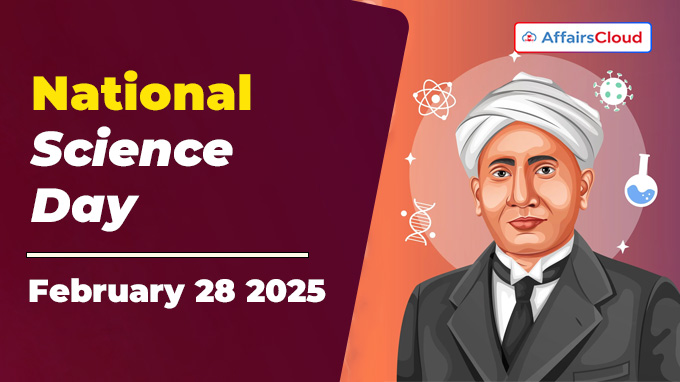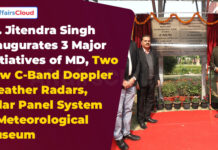
National Science Day (NSD) is observed annually on February 28 across India to honor the groundbreaking discovery of the ‘Raman Effect‘ by Sir Chandrasekhara Venkata Raman (CV Raman), a pioneering Indian physicist, in 1928. This day serves to highlight the importance of science in everyday life and acknowledges the invaluable contributions of scientists in shaping the progress of India.
- 28th February 2025 marks the observance of the 39th NSD.
- The theme of NSD 2025, “Empowering Indian Youth for Global Leadership in Science and Innovation for Viksit Bharat,” highlights the role of young minds in advancing India’s scientific and technological growth, in line with the vision of Viksit Bharat 2047, which aims for a developed and self-reliant India.
Background:
i.In 1986, the National Council for Science and Technology Communication (NCSTC) recommended to the Government of India (GoI) that February 28 be designated as NSD.
- The first-ever NSD was observed on February 28, 1987.
ii.Since 1987, NSD has been celebrated on February 28 to honor the discovery of the Raman Effect.
About Sir CV Raman:
i.Sir CV Raman was born on November 7, 1888, in Tiruchirappalli, Tamil Nadu (TN).
ii.In 1907, he joined the Indian Finance Service (IFS), a position that allowed him to continue his scientific research during his spare time.
iii.In 1917, he was appointed as the first Palit Professor of Physics at the University of Calcutta, informally known as Calcutta University (CU) in Kolkata (West Bengal, WB).
- In 1919, he also served as the Honorary Secretary of the Indian Association for the Cultivation of Science (IACS) in Kolkata.
iv.In 1928, he discovered the ‘Raman Effect’, observing that when light passes through a transparent material, a portion of the light changes its wavelength, providing insights into molecular structures.
v.He also served as a professor at the Indian Institute of Science (IISc) in Bengaluru (Karnataka) from 1933 to 1948.
vi.In 1948, he established the ‘Raman Research Institute’ (RRI) in Bengaluru, where he continued his research and served as its Director until his passing on November 21, 1970.
Awards and Honors:
i.In 1930, he received the ‘Nobel Prize’ in Physics for his groundbreaking discovery of the “Raman Effect” and became the first Asian to receive a Nobel Prize in a scientific field.
ii.In 1954, he was honored with the ‘Bharat Ratna’ (Science & Engineering), India’s highest civilian award, alongside Chakravarti Rajagopalachari and Sarvepalli Radhakrishnan.
iii.In 1957, he received the ‘Lenin Peace Prize’ for his dedication to scientific progress and peace.
iv.He was elected a Fellow of the Royal Society in 1924 and was knighted in 1929.
Legacy:
- Institutions Named After Him: RRI in Bengaluru and the C.V. Raman Road in Bengaluru.
- Commemorations: Postal stamps featuring him were issued in 1971 and 2009.
India’s Key Advancements in S&T:
i.Global Ranking: In 2024, India achieved significant progress in S&T, ranked 39th in the Global Innovation Index (GII) 2024, and secured the 6th position in global Intellectual Property (IP) filings, as reported by the World Intellectual Property Organization (WIPO).
ii.ANRF: Anusandhan National Research Foundation (ANRF) under the ANRF Act 2023 aims to boost India’s Research and Development (R&D) ecosystem. Key programs under the ANRF include:
- PM Early Career Research Grant (PMECRG), supporting young researchers.
- Electric Vehicle (EV) Mission, focused on sustainable mobility innovation.
- Partnerships for Accelerated Innovation and Research (PAIR), promoting collaboration in scientific research.
- Inclusivity Research Grant (IRG), which provides financial support to researchers from Scheduled Castes (SC) and Scheduled Tribes (ST).
iii.NQM: India has invested Rs.6003.65 crore over 8 years in the National Quantum Mission (NQM), aiming to lead in quantum technologies.
- A total of 152 researchers from 43 institutions across 17 States and 2 Union Territories (UTs) are involved.
iv.National Supercomputing Mission (NSM): India’s supercomputing infrastructure expanded to 32 PetaFlops in 2024, with a future target of 77 PetaFlops.
- New systems were commissioned at the Inter-University Accelerator Centre (IUAC) in New Delhi (Delhi), the National Centre for Radio Astrophysics (NCRA) in Pune (Maharashtra), and the S.N. Bose National Centre for Basic Sciences (SNBNCBS) in Kolkata (West Bengal, WB).
v.AI & Cyber-Physical Systems: The BharatGen initiative under the National Mission on Interdisciplinary Cyber-Physical Systems (NM-ICPS) launched India’s first multimodal Large Language Model (LLM) for Generative Artificial Intelligence (GenAI).
vi.Geospatial Science & Climate Research: India is increasing the adoption of geospatial technologies, with Spatial Thinking Programs (STP) reaching 116 schools across 7 states.
- 4 new Centres of Excellence (CoE) have been launched for climate resilience, focusing on flood and drought risk mapping.
viii.INSPIRE: The Innovation in Science Pursuit for Inspired Research (INSPIRE) program continues to foster young scientific talent, with 34,343 INSPIRE Scholars, 3,363 INSPIRE Fellows, and 316 INSPIRE Faculty Fellows receiving support for higher education and research.
- The INSPIRE-MANAK scheme will expand to engage Class 11 and 12 students from 2025, strengthening India’s scientific workforce and global research leadership.
ix.Gender equality in Science, Technology, Engineering & Mathematics (STEM): Initiatives like Women in Science and Engineering-Knowledge Involvement in Research Advancement through Nurturing (WISE-KIRAN), supports women scientists and engineers.
- Additionally, the Vigyan Jyoti Program encourages young girls to enter STEM fields, fostering a more inclusive scientific community.
2025 Events:
i.On the occasion of NSD, the Defence Research and Development Organisation (DRDO) of New Delhi (Delhi), the Aeronautical Society of India (AeSI) of New Delhi, and the Kalam Institute of Youth Excellence (KIYE) of Hyderabad (Telangana) hosted an event at Gachibowli Stadium in Hyderabad..
- The two-day celebration includes an Aerospace Exhibition with 200 stalls, attracting 20,000 students.
- It aims to inspire innovation, showcase India’s defence advancements, and encourage STEM careers.
About National Council for Science and Technology Communication (NCSTC):
i.NCSTC, established in 1982 is an initiative by the GoI, operating under the Department of Science and Technology (DST), Ministry of Science and Technology (MoS&T).
ii.Its primary mission is to popularize Science and Technology (S&T), fostering a scientific temper among the populace. NCSTC acts as a nodal agency to support and coordinate the celebration of NSD.




